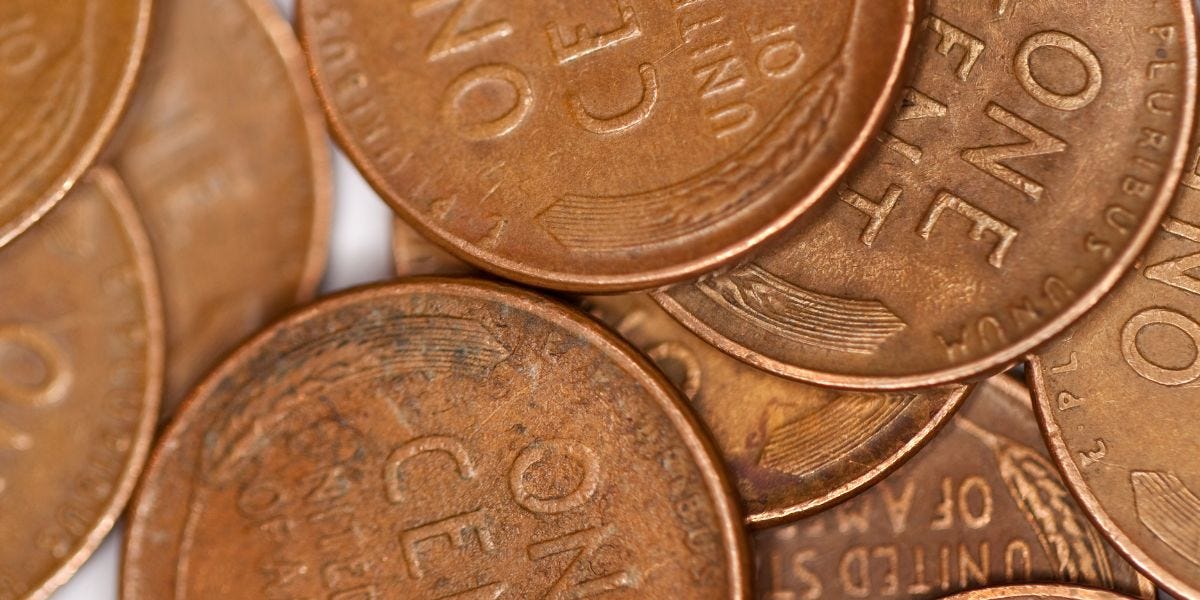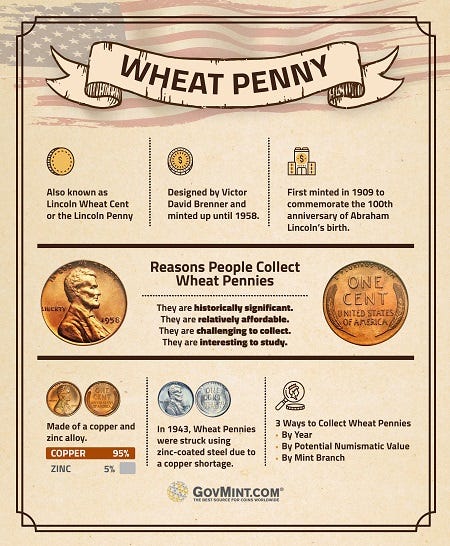Local Storage seems to be disabled in your browser.
For the best experience on our site, be sure to turn on Local Storage in your browser.
Complete Guide To Collecting Wheat Pennies

By GovMint :
Table of Contents
The History of U.S. Wheat Pennies & Their Face Value
Wheat pennies, also known as Lincoln Wheat Cents or the Lincoln Penny, were first minted in 1909 to commemorate the 100th anniversary of Abraham Lincoln's birth. They were minted up until 1958 and feature a portrait of Abraham Lincoln on the front and two ears of wheat on the reverse. With a face value of one cent, Victor David Brenner designed the coin, and it was produced at three different Mint facilities: Philadelphia, Denver, and San Francisco (Yeoman, R. S., et al. A Guide Book of United States Coins. 73rd ed., Whitman Publishing, LLC, 2019, p. 119-120).


Embed this graphic on your website:
<a href="https://www.govmint.com/coin-authority/post/complete-guide-to-collecting-wheat-pennies"><img src="https://www.govmint.com/v~4b.53/media/wysiwyg/Wheat_Penny_Facts_2.jpg" alt="Complete Guide to Collecting Wheat Pennies" width="500" border="0"></a><br>Source: <a href="https://www.govmint.com/coin-authority/post/complete-guide-to-collecting-wheat-pennies">Complete Guide to Collecting Wheat Pennies</a><br>
Why Collect Wheat Pennies?
People collect wheat pennies for a variety of reasons:
-
They are a piece of American history: Wheat pennies were produced for nearly 50 years and widely used in circulation, so they offer a glimpse into the past.
-
They are affordable and accessible: Wheat pennies can be relatively inexpensive to collect, depending upon the year of issue and condition, making them accessible to people of all budgets.
-
They are a challenge to collect: With many different date and mint mark combinations, collecting wheat pennies can be a challenging and rewarding hobby.
-
They are interesting to study: Wheat pennies have different variations, errors, and mintage numbers, which make them interesting to study, understand, and discover.
Is a Wheat Penny Rare?
A wheat penny is not considered to be a rare coin in general. The coin was produced in large numbers, and many were saved as keepsakes or passed down through families. However, some specific date and mint mark combinations can be considered rare. For example, the 1909-S VDB (San Francisco, 1909, with initials of designer Victor D. Brenner) is considered to be rare and highly sought after by collectors due to its low mintage.
The 1943 Bronze Wheat Penny is another example. During World War II, the United States Treasury Department ordered the Mint to produce one-cent coins made of zinc-coated steel in order to conserve copper for the military. In 1943, a small number of leftover bronze planchets got accidentally mixed in with the steel planchets and struck as 1943 Bronze Wheat Pennies. Likewise, in 1944, an estimated 25-30 wheat pennies were accidentally struck on steel planchets instead of copper.
Thanks to their composition and scarce supply, the 1943 Bronze and 1944 Steel Wheat Penny are some of the rarest and potentially most valuable wheat pennies.
How To Tell if You Have a Wheat Penny?
To determine if you have a wheat penny, you must look for a few key characteristics. The first is the date. Wheat pennies were produced from 1909 to 1958, so if your coin has a date outside of that range, it is not a true wheat penny. Design is another characteristic to look for. Wheat pennies feature a portrait of Abraham Lincoln on the obverse and two ears of wheat on the reverse. If your coin does not have this design, it is not a wheat penny. Additionally, wheat pennies are made of a copper-zinc alloy, which gives them a distinct color and weight compared to other coins.
Another way to tell if you have a wheat penny is to check its mint mark, a small letter on the coin that indicates where it was minted. The Philadelphia-minted pennies do not have a mint mark, Denver-minted pennies have a "D," and San Francisco-minted pennies have an "S."
How Much Copper Is in a Wheat Penny?
The Wheat Penny is made of a copper and zinc alloy, with the copper content being 95%. This means that a wheat penny contains 0.095 ounces of copper per coin (The Official Red Book, p. 120).
In 1943, due a copper shortage during World War II, Wheat Pennies were struck using zinc-coated steel. From 1944 to 1958, the series returned to its original bronze composition.
How Much Are Wheat Pennies Worth?
All Wheat Pennies have a face value of one cent. However, due to their rarity and condition, some Lincoln Pennies have been known to sell for hundreds of thousands of dollars.
According to The Fun Times Guide, the steel 1944 Wheat Penny may be worth between $85,000 and $110,000, depending on its condition. However, CoinWeek explains that even some common-date wheat pennies can still sell for up to $5 or more in Mint State 65 condition.
How To Collect Wheat Pennies
Starting to collect wheat pennies is a great way to get into the world of coin collecting. Here are a few tips to get you started:
-
Learn about the coin: Familiarize yourself with the design, composition, and history of the Wheat Penny. This will help you identify and understand the coin better.
-
Get a coin album or folder: This will allow you to organize and store your wheat pennies.
-
Start collecting: You can purchase wheat pennies from coin dealers, online coin retailers, or at coin shows. You can also look for wheat pennies in your own pocket change or at garage sales and estate sales.
-
Learn about coin conditions: It is important to learn how to determine a coin’s general condition because the condition of a coin can greatly affect its value. Coins certified by third-party grading services like Numismatic Guaranty Company (NGC) or Professional Coin Grading Service (PCGS), are great options for those seeking wheat pennies in higher grades.
What Should I Look for When Collecting U.S. Wheat Pennies?
When collecting U.S. wheat pennies, you’ll want to look for several key things to build a valuable and interesting collection. As previously mentioned, you should focus on the date and mint mark of the coin first. Some date and mint mark combinations, such as the 1909-S VDB, are considered to be rare and highly sought after by collectors.
The condition of the coin is another important aspect. Coins that are in good condition, also known as "uncirculated" or "mint state," are more valuable than coins that show signs of wear and tear, known as "circulated" coins. Grading is the process of determining the condition of a coin, so learn how to grade your coins.
You should also look for the type of errors or varieties that could have occurred while the coin was struck, such as a doubled die, repunched mint mark, or off-center strikes. These types of errors and varieties can increase the coin’s numismatic value.
3 Ways To Collect Wheat Pennies
How you build and organize your wheat penny collection is up to you. But if you’re not sure how to begin, here are three ways to start your collection:
#1. By Year
Collecting wheat pennies by the year they were minted is a popular method of organizing and building a collection. This method of collecting allows you to focus on the historical significance of each coin and trace the evolution of the Wheat Penny over time.
To collect wheat pennies by the year they were minted, you will need to research the different date and mint mark combinations for wheat pennies. Again, wheat pennies were minted from 1909 to 1958, so you will need to identify which date and mint mark combinations you would like to focus on. Some collectors choose to collect every date and mint mark combination from the entire series, while others might focus on specific date ranges or other criteria.
#2. By Potential Numismatic Value
Collecting wheat pennies by their potential numismatic value is another method of organizing and building a collection. This method of collecting is often used by those who are interested in the investment aspect of coin collecting.
To collect wheat pennies by value, you will need to research and identify which wheat pennies are considered to be the most valuable. This can be done by consulting coin pricing guides, researching online, or consulting with coin experts.
Note that the value of coins can fluctuate, depending on the market demand, rarity, and condition of the coin. Additionally, it's important to remember that the value of a coin is not based solely on its rarity but also the strike, preservation, and grade.
#3. By Mint Branch
Another way to build and organize your wheat penny collection is by seeking wheat pennies struck at all, or specific, branches of the United States Mint. As mentioned further above, this series was released by the Denver, San Francisco, and Philadelphia Mints, over the course of its issuance, resulting in a multitude of date and mint mark combinations. There are several ways collectors can go about this strategy. Collectors could seek out examples of wheat pennies struck at the various branch mints in a given year. For example, in 1911, the Denver, Philadelphia, and San Francisco branches of the United States Mint all issued wheat pennies into circulation. Alternatively, collectors could build a collection based upon a specific branch mint, such as seeking out an example of each wheat penny struck at the Denver Mint over the course of the series.
Collecting wheat pennies by which branch of the United States Mint they were struck at can also be a worthwhile venture because certain date and mint mark combinations have lower mintages, making them more scarce. For example, in 1914, only 1,193,000, wheat pennies were struck at the Denver Mint, compared to 75,238,432 that were struck at the Philadelphia Mint.
Where To Buy Wheat Pennies
You can purchase wheat pennies from several sources. Coin dealers, coin shops, coin shows and conventions, and online coin retailers are the most traditional sources to purchase from. These stores specialize in coin collecting and typically carry a wide variety of coins, including wheat pennies.
Keep in mind that you should only buy from a reputable or trusted seller. To ensure you’re buying from a trusted dealer, visit our site at GovMint.com. We’re an accredited business for over 30 years and offer wheat pennies and other collectible coins at fair prices.
Wheat Penny Testimonials
Steven H., who bought a 1909-1958 Wheat Pennies 3 Troy Pound Bag, said:
James T., who bought a 1909 Lincoln Cent in XF condition, said:
Raymond W., who bought a 1909-1958 Wheat Pennies 5 Troy Pound Bag said:
Ralph L., who bought a 1910–1929 Three-Pound Bag (360 Coins) of Lincoln Wheat-Back Cents, said:
For further reading, check out our other comprehensive coin guides down below!
Guide To Collecting Steel Pennies
Guide To Collecting Half Dollars
Guide To Collecting Silver Dollars
Guide To Collecting Gold Eagles
Guide To Collecting Gold Coins
© 2024 Copyright GovMint.com. All Rights Reserved. GovMint.com does not sell coins and numismatics as investments, but rather as collectibles. Please review GovMint's Terms and Conditions, Terms of Use and Privacy Policy before using this website and prior to purchasing from GovMint.com.













